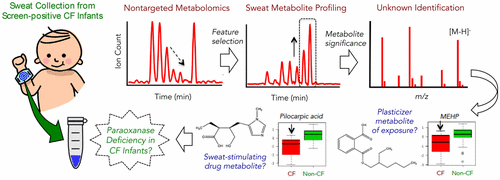当前位置:
X-MOL 学术
›
ACS Cent. Sci.
›
论文详情
Our official English website, www.x-mol.net, welcomes your feedback! (Note: you will need to create a separate account there.)
The Sweat Metabolome of Screen-Positive Cystic Fibrosis Infants: Revealing Mechanisms beyond Impaired Chloride Transport
ACS Central Science ( IF 18.2 ) Pub Date : 2017-07-31 00:00:00 , DOI: 10.1021/acscentsci.7b00299 Adriana N. Macedo 1 , Stellena Mathiaparanam 1 , Lauren Brick 2 , Katherine Keenan 3 , Tanja Gonska 3, 4 , Linda Pedder 2 , Stephen Hill 5 , Philip Britz-McKibbin 1
ACS Central Science ( IF 18.2 ) Pub Date : 2017-07-31 00:00:00 , DOI: 10.1021/acscentsci.7b00299 Adriana N. Macedo 1 , Stellena Mathiaparanam 1 , Lauren Brick 2 , Katherine Keenan 3 , Tanja Gonska 3, 4 , Linda Pedder 2 , Stephen Hill 5 , Philip Britz-McKibbin 1
Affiliation

|
The sweat chloride test remains the gold standard for confirmatory diagnosis of cystic fibrosis (CF) in support of universal newborn screening programs. However, it provides ambiguous results for intermediate sweat chloride cases while not reflecting disease progression when classifying the complex CF disease spectrum given the pleiotropic effects of gene modifiers and environment. Herein we report the first characterization of the sweat metabolome from screen-positive CF infants and identify metabolites associated with disease status that complement sweat chloride testing. Pilocarpine-stimulated sweat specimens were collected independently from two CF clinics, including 50 unaffected infants (e.g., carriers) and 18 confirmed CF cases. Nontargeted metabolite profiling was performed using multisegment injection–capillary electrophoresis–mass spectrometry as a high throughput platform for analysis of polar/ionic metabolites in volume-restricted sweat samples. Amino acids, organic acids, amino acid derivatives, dipeptides, purine derivatives, and unknown exogenous compounds were identified in sweat when using high resolution tandem mass spectrometry, including metabolites associated with affected yet asymptomatic CF infants, such as asparagine and glutamine. Unexpectedly, a metabolite of pilocarpine, used to stimulate sweat secretion, pilocarpic acid, and a plasticizer metabolite from environmental exposure, mono(2-ethylhexyl)phthalic acid, were secreted in the sweat of CF infants at significantly lower concentrations relative to unaffected CF screen-positive controls. These results indicated a deficiency in human paraoxonase, an enzyme unrelated to mutations to the cystic fibrosis transmembrane conductance regulator (CFTR) and impaired chloride transport, which is a nonspecific arylesterase/lactonase known to mediate inflammation, bacterial biofilm formation, and recurrent lung infections in affected CF children later in life. This work sheds new light into the underlying mechanisms of CF pathophysiology as required for new advances in precision medicine of orphan diseases that benefit from early detection and intervention, including new molecular targets for therapeutic intervention.
中文翻译:

筛查阳性囊性纤维化婴儿的汗液代谢组:氯离子转运受损以外的揭示机制。
汗液氯化物测试仍然是证实囊性纤维化(CF)的金标准,以支持新生儿普查程序。但是,鉴于基因修饰剂和环境的多效性,当对复杂的CF疾病谱进行分类时,它为中等汗液氯化物病例提供了模棱两可的结果,而没有反映疾病的进展。本文中,我们报告了筛查阳性CF婴儿的汗液代谢组的第一个特征,并鉴定了与疾病状态相关的代谢产物,这些物质补充了汗液氯化物测试。从两个CF诊所独立收集毛果芸香碱刺激的汗液标本,包括50名未受影响的婴儿(例如携带者)和18例确诊的CF病例。使用多段进样-毛细管电泳-质谱分析法作为高通量平台进行非目标代谢物谱分析,以分析体积受限的汗液样品中的极性/离子代谢物。使用高分辨率串联质谱法在汗液中鉴定出氨基酸,有机酸,氨基酸衍生物,二肽,嘌呤衍生物和未知的外源性化合物,包括与受影响但无症状的CF婴儿相关的代谢产物,例如天冬酰胺和谷氨酰胺。出乎意料的是,用于刺激汗液分泌的毛果芸香碱代谢产物,毛果酸和环境暴露引起的增塑剂代谢产物单(2-乙基己基)邻苯二甲酸以相对较低的CF筛查浓度显着降低了CF婴儿的汗液分泌。阳性对照。这些结果表明人类对氧磷酶缺乏,这种酶与囊性纤维化跨膜电导调节剂(CFTR)的突变和氯化物运输受损无关,是一种非特异性芳基酯酶/内酯酶,已知可介导炎症,细菌生物膜形成和肺部反复感染。在以后的生活中影响了CF儿童。这项工作为孤儿疾病精密医学的新进展所需要的CF病理生理学的潜在机制提供了新的亮点,这些疾病得益于早期发现和干预,包括治疗性干预的新分子靶点。这是一种非特异性的芳基酯酶/内酯酶,已知可以在以后的CF儿童中介导炎症,细菌生物膜形成和反复出现的肺部感染。这项工作为CF病理生理学的潜在机制提供了新的亮点,这是孤儿疾病精密医学的新进展所需要的,而该疾病得益于早期发现和干预,包括治疗性干预的新分子靶标。这是一种非特异性的芳基酯酶/内酯酶,已知可以在以后的CF儿童中介导炎症,细菌生物膜形成和反复出现的肺部感染。这项工作为CF病理生理学的潜在机制提供了新的亮点,这是孤儿疾病精密医学的新进展所需要的,而该疾病得益于早期发现和干预,包括治疗性干预的新分子靶标。
更新日期:2017-08-23
中文翻译:

筛查阳性囊性纤维化婴儿的汗液代谢组:氯离子转运受损以外的揭示机制。
汗液氯化物测试仍然是证实囊性纤维化(CF)的金标准,以支持新生儿普查程序。但是,鉴于基因修饰剂和环境的多效性,当对复杂的CF疾病谱进行分类时,它为中等汗液氯化物病例提供了模棱两可的结果,而没有反映疾病的进展。本文中,我们报告了筛查阳性CF婴儿的汗液代谢组的第一个特征,并鉴定了与疾病状态相关的代谢产物,这些物质补充了汗液氯化物测试。从两个CF诊所独立收集毛果芸香碱刺激的汗液标本,包括50名未受影响的婴儿(例如携带者)和18例确诊的CF病例。使用多段进样-毛细管电泳-质谱分析法作为高通量平台进行非目标代谢物谱分析,以分析体积受限的汗液样品中的极性/离子代谢物。使用高分辨率串联质谱法在汗液中鉴定出氨基酸,有机酸,氨基酸衍生物,二肽,嘌呤衍生物和未知的外源性化合物,包括与受影响但无症状的CF婴儿相关的代谢产物,例如天冬酰胺和谷氨酰胺。出乎意料的是,用于刺激汗液分泌的毛果芸香碱代谢产物,毛果酸和环境暴露引起的增塑剂代谢产物单(2-乙基己基)邻苯二甲酸以相对较低的CF筛查浓度显着降低了CF婴儿的汗液分泌。阳性对照。这些结果表明人类对氧磷酶缺乏,这种酶与囊性纤维化跨膜电导调节剂(CFTR)的突变和氯化物运输受损无关,是一种非特异性芳基酯酶/内酯酶,已知可介导炎症,细菌生物膜形成和肺部反复感染。在以后的生活中影响了CF儿童。这项工作为孤儿疾病精密医学的新进展所需要的CF病理生理学的潜在机制提供了新的亮点,这些疾病得益于早期发现和干预,包括治疗性干预的新分子靶点。这是一种非特异性的芳基酯酶/内酯酶,已知可以在以后的CF儿童中介导炎症,细菌生物膜形成和反复出现的肺部感染。这项工作为CF病理生理学的潜在机制提供了新的亮点,这是孤儿疾病精密医学的新进展所需要的,而该疾病得益于早期发现和干预,包括治疗性干预的新分子靶标。这是一种非特异性的芳基酯酶/内酯酶,已知可以在以后的CF儿童中介导炎症,细菌生物膜形成和反复出现的肺部感染。这项工作为CF病理生理学的潜在机制提供了新的亮点,这是孤儿疾病精密医学的新进展所需要的,而该疾病得益于早期发现和干预,包括治疗性干预的新分子靶标。



























 京公网安备 11010802027423号
京公网安备 11010802027423号